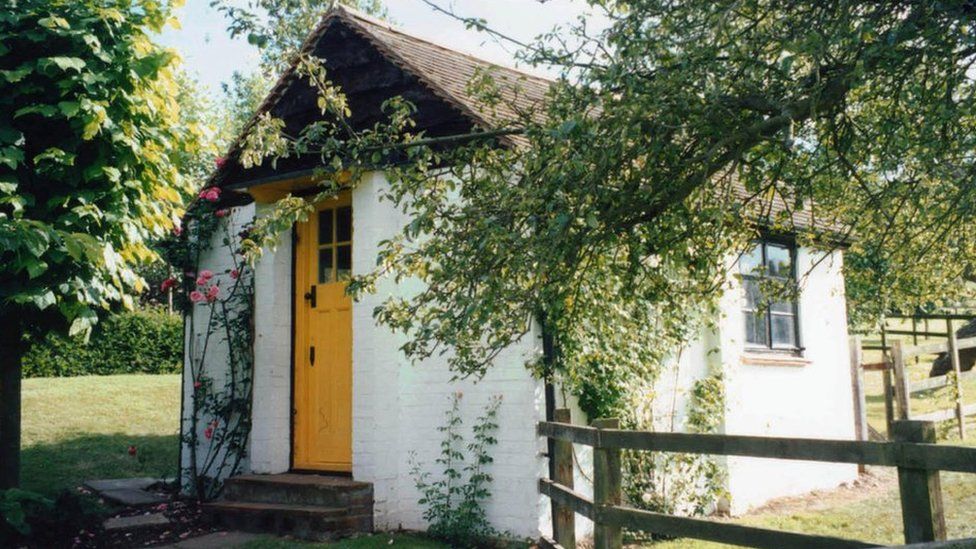How Dylan Thomas's writing shed inspired Roald Dahl
- Published

Both are world-famous authors who wrote some of their best known works in their sheds. But, as Roald Dahl's centenary is celebrated across the country, his widow reveals how heavily the children's author was influenced by Dylan Thomas's hut when building his own.
They are two writers famous for completely different types of writing.
Roald Dahl is celebrated for his imaginative children's stories, and Dylan Thomas for his poetry.
But it was Thomas who Dahl turned to for inspiration when he struggled to sit down and write in his house.
As a father of young children and with a bustling home, Cardiff-born Dahl initially found it hard to shut himself off and write.
Finding too many distractions in his house, he remembered fellow Welshman Dylan Thomas, who he called "the greatest poet of our time", had found a peaceful shed to write in close to home.
Thomas wrote works such as Under Milk Wood, Do Not Go Gentle into That Good Night, Over Sir John's Hill and Poem on His Birthday inside his hut.
The writing shed was a former garage teetering on the edge of a cliff, with a view of the hills, the town of Laugharne and the Taf estuary below.
Dahl travelled to visit Thomas's hut in Carmarthenshire in the 1950s and, peering through the window, decided to make a replica of it to write in.
"My little nest"
Surrounded by pictures (1), inspirational quotes and photos of family and friends (2), Dahl sat in a wing-back chair, which used to be his mother's, with a hole cut in it to relieve the pressure on an abscess he developed in his back (3).
While writing, he rested his legs on a battered suitcase, covering them with a sleeping bag when they got cold (4).
The writer used a cardboard tube with a piece of wood propped on top to work at, writing purely with pencils on yellow paper (8). He had a rubbish bin on one side for rejected pages (7), and a filing cabinet and books on the other (5).
His desk was a place for mementoes to inspire him, with objects such as the hip bone he kept after a hip replacement, and a ball made out of silver foil chocolate wrappers (9).
Although Dahl based the design of his hut on Thomas's shed, there was one major difference - the lack of natural light. He often kept his curtains drawn (10) to block out the outside world and was dependant on an angle-poise lamp (6) for light.
Dahl's widow Felicity said the shed was an escape for the writer
Dahl's widow Felicity said: "He realised he had to have a space of his own in the garden away from the children and the noise and the general domesticity and he remembered that Dylan had felt the same.
"And so he went down to Wales to look at Dylan's writing hut and, like everybody, fell in love with it."
Built to the same proportions, with the same angled roof - the similarities could be a coincidence. But according to his widow it was built in a similar design by Dahl's builder friend Wally Saunders, who the BFG was based on.
"He built it exactly to the same proportions as Dylan's hut, the same roof, one skin of brick," said Mrs Dahl. "Of course Dylan's hut was a garage originally, whereas Roald had nothing, it was an empty space that he built on."
"My word-splashed hut"
While Dahl wrote in semi-darkness, Thomas had large windows (10) to take in the beautiful view from his writing shed perched on stilts on the cliff above the boathouse, where he lived in Laugharne.
Built as a garage by a previous owner, the poet filled his "word-splashed hut" with curled pictures of Byron, Walt Whitman, Louis MacNeice, WH Auden (1 and 2) as well as lists of alliterative words beside his pencil pot (8).
He sat on a simple chair (3) writing on paper (4), while throwing rejected pages onto the floor (5).
Like Dahl, he kept books on hand (6), mementoes to inspire him (9) and he also kept a supply of boiled sweets on his desk (7).
Mrs Dahl visited Thomas's hut recently.
She said: "It was so similar to Roald's hut. Everything was very simple, and Roald was like that, he didn't want rich yachts, he wanted a simple life, he was a countryman, again, like Dylan."
Dahl wrote many of his books in the hut in the garden of his home Gipsy House in Great Missenden, Buckinghamshire, which was recently moved to the nearby Roald Dahl Story Museum at a cost of £500,000.
Describing his writing shed on BBC Radio 4's Desert Island Discs programme in 1979, Dahl described the haven he had created.
He said: "A little hut, curtains drawn so I don't see the squirrels up in the apple trees in the orchard. The light on, right away from the house, no vacuum cleaners, nothing."
He added: "When I am in this place it is my little nest. My womb."
- Published13 September 2016
- Published13 September 2016
- Published13 September 2011